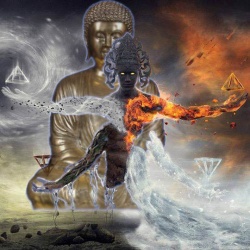Chag (Prostrations)
Chag or prostration is fundamentally a practice of paying respect but not about submission to others. It is aimed at getting rid of one’s greatest flaw, evil and enemy - the ego or the sense of I. One can find this practice in other religious tradition as well. In India as one greets, one says Namaste or chag tshelo, which is a way of showing respect to each other. In Buddhism, it is a practice of spiritual mind training.
It is practiced to eradicate or suppress the ego through humility and selflessness. If one is full of pride and arrogance, chag is said to bring down one’s ego because the mind is connected to the body.
Chag involves physically bringing down the five parts, the forehead, two palms and two knees on the ground. When one touches the ground with the five limbs one should be mindful and visualise that the five poisons or negative emotions are being brought down, reduced and eradicated. The five poisons are ignorance, attachment, hatred, jealousy and pride, which come out of ego. The purpose of chag will be incomplete without the practice of such mindfulness and visualisation. As one stands up, one should visualise that as the five poisons are lessened, one is receiving the five aspects of enlightenment, which are the enlightened body, speech, mind, qualities and activities (ku, sung, thug, yonten, thinley) of the Buddha.
What should one think while practising chag?
There are many ways of practising chag meditation but three primary types of practising chag, which are basic, intermediate and advanced levels of chag.
On the basic level, one can practice chag with humility, courtesy and respect and mindfulness that ‘I am humbly prostrating to the Buddha, and through this I am lessening the five poisons and attaining the five qualities of the Buddha’.
On the intermediate level, one can imagine that one has multiplied into innumerable forms like the dusts on earth. Each time one makes a prostration; one imagines that all the innumerable forms are making prostration. One can visualise that one is making chag in multiple forms. This is called trul pai chag or prostration of emanation where one manifest into millions and zillions of forms.
The best chag is called ta wai chag, which is done through the right viewpoint and right understanding. One must have the realisation that when one is making prostration, there is no ‘I’, who is prostrating, the Buddha or lama, to whom the prostration is being made, and the act of prostration. Everything is an illusion. Then, every step in the process of chag becomes an illusory process where there is only an illusory person doing an illusory prostration, there is no real person doing or receiving the prostration. Everything is empty without any subject-object duality. This is the ultimate and best form of chag, which goes in line with the ultimate understanding of reality.
Many Bhutanese concentrate on number of chag but this is said to be wrong. Numbers will give an indication to the mental will power of the person but if one sticks only to the numbers and do not do prostrations with mindfulness, then it becomes a mere physical exercise. A few hundred chag with good concentration is better than tens of thousands of chag without good or proper concentration and visualisation as it all comes down to the training of mind. Doing chag is said to bring about good physique and great respect from others as karmic result.
Source
[[1]]
